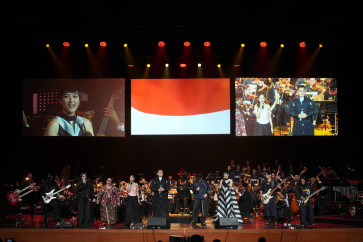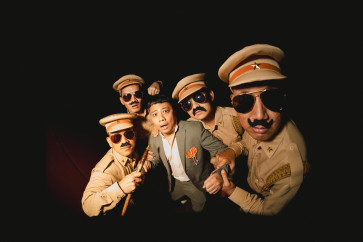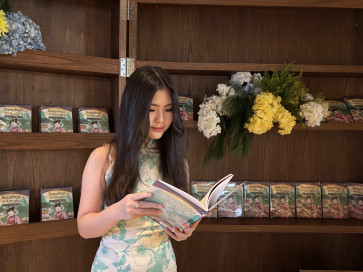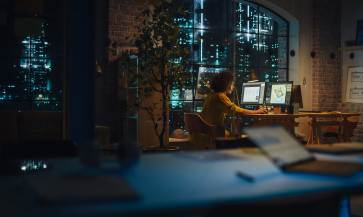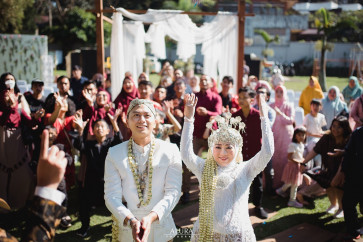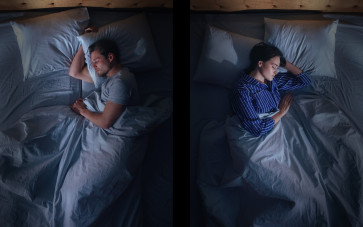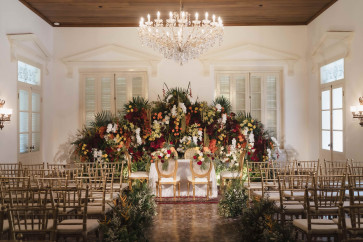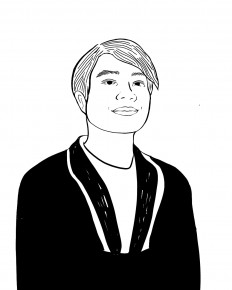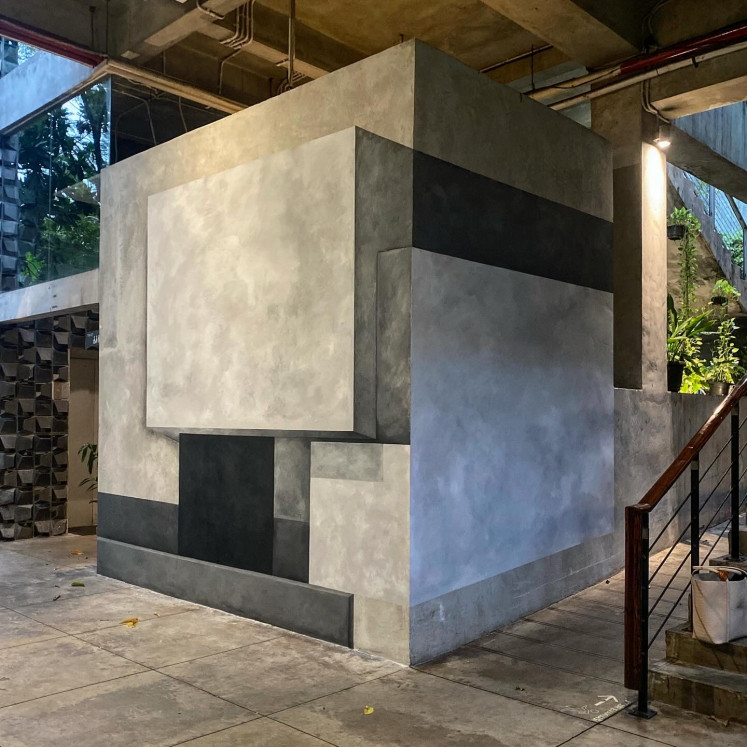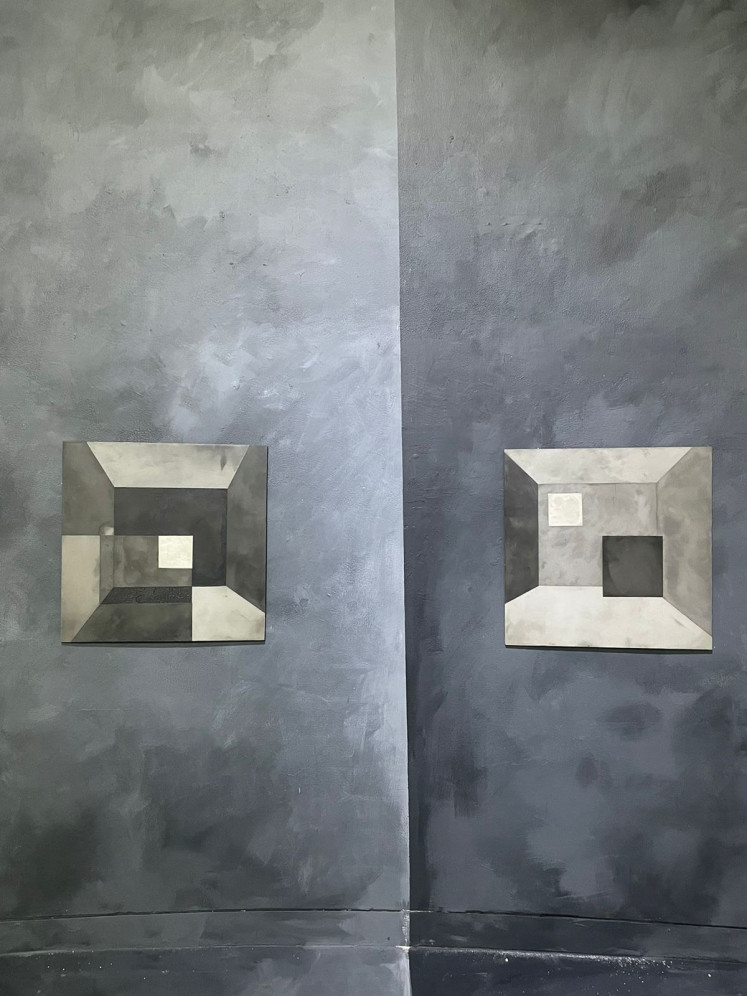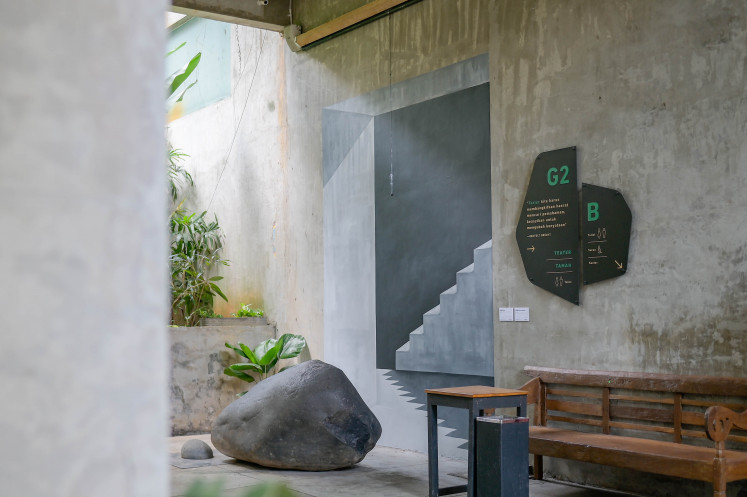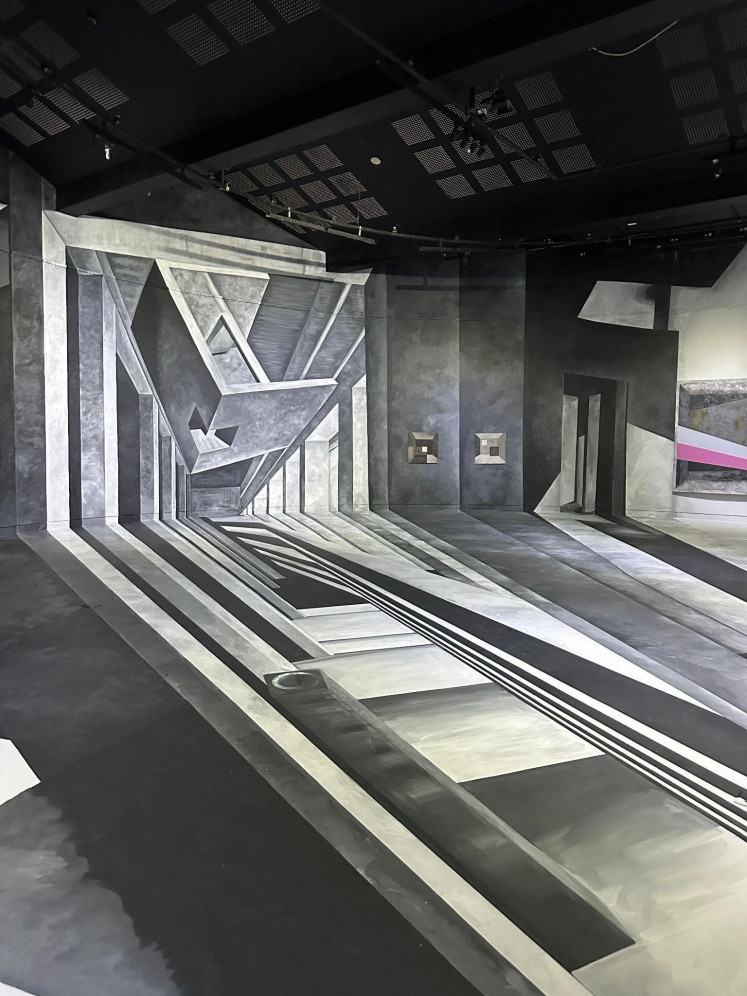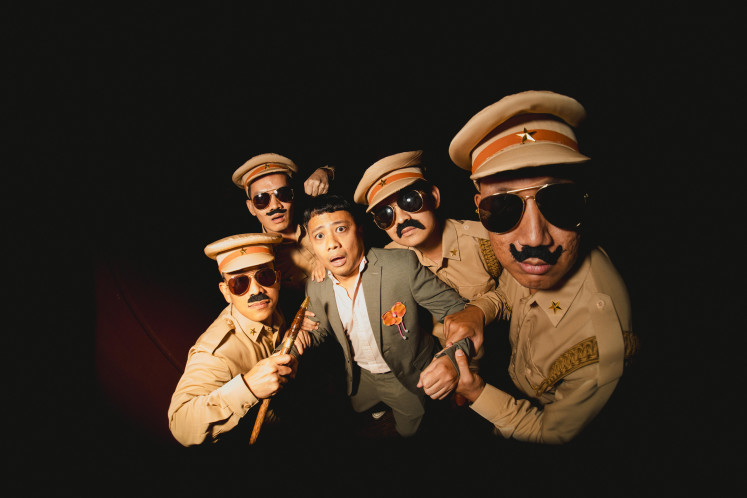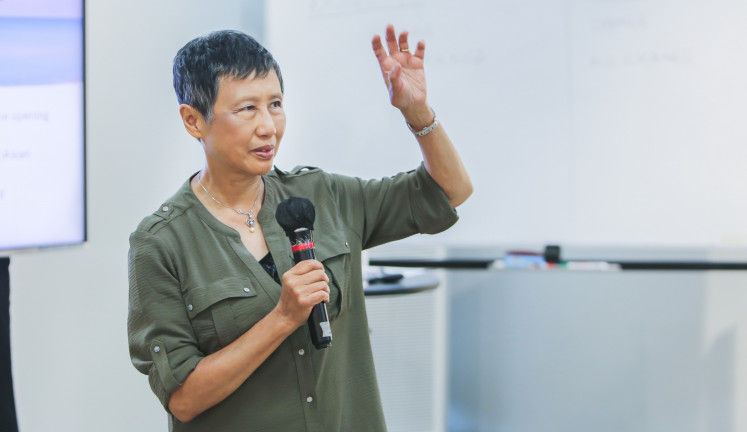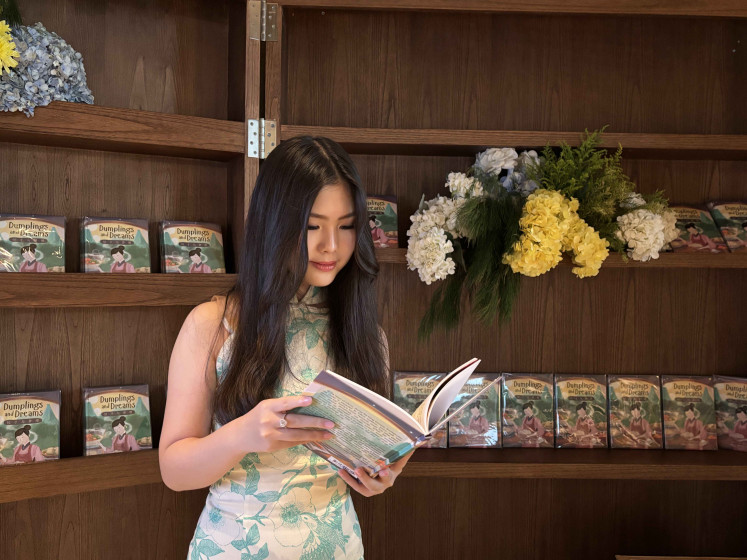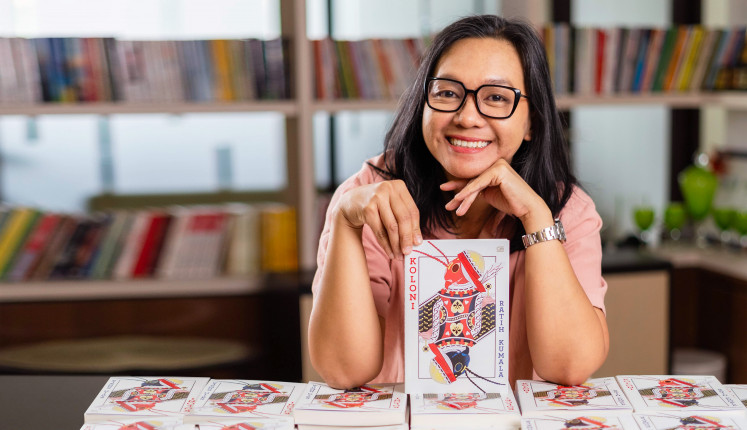(Courtesy of Common Sanctum)
As soon as I walk into the space, I am enveloped in a massive, enchanting mural and a roster of engaging paintings. A pervasive soundscape of nature and construction echoes around me.
I immediately get a sense that this “Common Sanctum” exhibit from the architect-turned-artist Bunga Yuridespita at the Salihara Art Center is an immersive and delightful experience.
On one side, Bunga hangs a slew of paintings that play with blocky three-dimensional shapes, utilizing vibrant solid colors from a birds-eye view perspective. While on the other, she utilizes rough grays to create paintings of desolate rooms, evoking the grim passage of time.
(Courtesy of Common Sanctum)
The highlight of the exhibit, however, is the imposing gallery-wide mural right at the center of the space. Guests can freely walk up to the mural, which crosses over the floors in a pervasiveness that surrounds its viewers.
I stare at it, not quite sure what it's supposed to be. It looks like an alleyway in a brutalist building you’d find in London’s Barbican, but also kind of an MC Escher-esque stairway. From a different angle, though, it echoes German expressionist paintings akin to those found in The Cabinet of Dr Caligari.
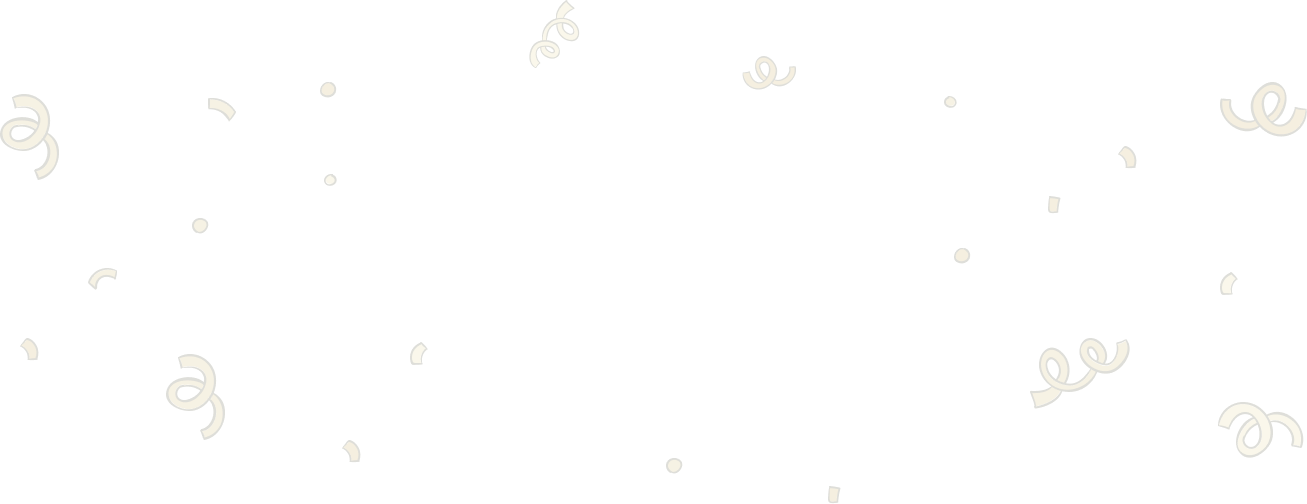
Thank you!
For signing up to our newsletter.
Please check your email for your newsletter subscription.
Before I realize it, I have spent way too much time immersed in pondering the piece. Each visitor will definitely interpret it differently, and Bunga tells me that’s the point.
“Some people say that this is just abstract imagery, some people say that if you stand at this point it looks like stairs […] that’s what I want to get actually!
“When I made the mural, I might have not even realized what it could look like from different perspectives, my focus was to express my experience. So when people interact with my artwork, and let their imagination get different experiences from my experience, I get immensely happy.”
Read also: Fancy a fungal future?Architectural influence
The exhibit’s concentration on geometry and textures underscores Bunga’s background in architecture and its influence on her style as an artist today.
“Architects always begin everything from above, making maps, blueprints, master plans. And all architecture students have the habit of touching the material of buildings as they walk, to know how the texture feels like.”
As an architecture student, Bunga didn’t always know that she wanted to create art. Before starting her journey as an artist, she worked as an architecture consultant in Jakarta for a few years.
“During that time, I often doodled, which turned into painting. From there I just came to the conclusion that I wanted to develop my creative side, so I did a master’s degree in fine arts. I didn’t actually know at the time that I would end up as a painter.”
For Bunga, space plays an integral role in how she represents herself as both an artist and an architect. To her, using space as an art form symbolizes an abstraction of her personal identity and the passing of time.
“I believe that people are shaped by their experiences, so what I want to do is freeze the spaces that are intimate to me then translate them into artworks. So my work is a visual representation of my journey.”
(Courtesy of Common Sanctum)
She adds that another layer to her work is how she utilizes textures to convey time.
“You know when you see abandoned spaces, and you can see a dusty layer on the walls or cracks forming along the floors. That’s how I want to deliver my concept of time, through textures. Because when something’s new, it doesn’t have texture like that. The more time passes by, the dirtier it gets, and that shows history.”
I ask Bunga what art inspires her and who influences her work, and her answer surprises me.
“I’m a big fan of Stanley Kubrick. When I was studying architecture, I did a lot of research on him. Because he always used a lot of buildings with gigantic scales. Like the hotel in The Shining, with its long creepy halls, and its vast garden labyrinth.”
(Courtesy of Common Sanctum)
She adds that she is a huge fan of Japanese Architect Tadao Ando, who is famous for his creative use of concrete, something Bunga echoes in her utilization of gray textures.
“As for artists, there’s so many I’m a big fan of. Contemporary artists like Anish Kapoor, Richard Serra, and Olafur Eliasson, their work is always grand in scale, they envelop you, and their whole repertoire isn’t necessarily cohesive, but there is a red thread throughout their work. This is what I try to apply to my process, the scale and the diversity.
Read also: Sprucing up your home for a Lebaran open house
(Courtesy of Common Sanctum)
Interplay with space
A key aspect of this exhibition is the gallery itself. Being a solo exhibition, Bunga wanted to create a unique experience that is complimented by the space housing her exhibit. So around the beginning of 2023, Bunga began planning her exhibition with Salihara Arts Center’s founder, Gunawan Muhammad.
“Pak Gunawan suggested that my exhibition should be held in Salihara. I was excited, yet quite confused, because Salihara has such a distinct and unique space. The oval gallery where the exhibit is, is a vast area, and what I aimed to do was create a new spatial experience. I want people to enter the gallery and forget that the space is round by looking at the mural.”
Bunga explains that Salihara was a collaborative design by four architects: Andra Matin, Adi Purnomo, Marco Kusumawijaya and Danny Wicaksono. The space is therefore the result of those four architects responding to each other’s designs, and Bunga says she hopes her exhibit complements the work they have established.
“I want to show that the construction has endless possibilities for forms. That’s the idea, to create a new space using the one that already exists in Salihara.”
(Courtesy of Common Sanctum)
Closing my discussion with Bunga, I ask her about the state of the artists in Indonesia and how she hopes the Indonesian art scene will develop in the future.
“It's not as wild as the Western countries here, but I am noticing more and more meaningful collaborations between artists and brands. As an artist I want to play around with the product and make the collaboration more authentic.”
She concurs that the current trajectory of Indonesian artists shows that they are becoming more involved in the designing and creation process of products from collaborations, but at the moment it's not quite there yet.
Bunga then notes that she hopes the Indonesian government can improve its support for artists, as art is deeply rooted in Indonesian culture and identity. However, she also hopes that more critics appear in Indonesia, commenting that they can help artists improve their work while simultaneously providing exposure, and help make art more accessible to understand for the general public.
“I want the access to art to be more humble. That’s the function of the critic, the function of the curator, they can help to translate it to be lighter, more educative. With more of them around, the diversity of art in Indonesia can be exposed to an even wider community.
Read also: ‘Mega Mega’, the musical: A triumphant revisiting of a classic
This article is part of The Weekender, which comes out on the Saturday edition of The Jakarta Post. It offers a variety of lifestyle and culture articles aimed at enriching your reading experience. Subscribe
here to get access to the Saturday edition and all other premium content from the Post.




